
Growth in plants and animals (A-level biology)

Growth and development.
Growth is a permanent increase in the size of an organism by addition of more body substance. The pattern of growth differs in different organisms. In animals, it is described as being diffuse, with growth occurring in almost all parts of the body. For plants, however, have particular regions where they grow, called meristems.
Apical meristems are responsible for the increase in length while secondary meristems are responsible for the increase in girth or diameter of the stem. Three distinct processes contribute to growth; cell division, assimilation, and cell expansion.
Development; involve both an increase in size and differentiation of cell so that they become specialized.
Measuring growth
Growth can be quantified by measuring some features of the organism at a suitable interval such as
- Length: this is easy to do and does not damage the organism but results may be misleading it takes no account of growth in other direction.
- Area and volume are more accurate than measuring length but are impractical to measure.
- Fresh mass: this is easy to measure but may be inaccurate due to temporary fluctuation in water content
- Dry mass: this involves removing all water by drying before weighing. It is accurate but difficult to carry out and kills the organism
Growth curves
When any parameter is measured against set intervals of time, a growth curve is produced. For many populations, organism or organs, the curve is S-shaped or sigmoid curve. It represents a slow growth at first because there are so few cells initially that even when they are dividing rapidly the actual increase in size is small.

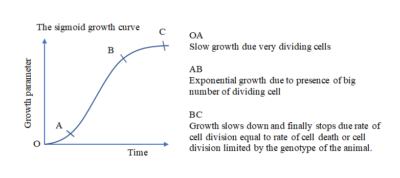
Allometric growth
This is growth where the different parts the organism may grow at different rates and stop growing at different times. This one problem of measuring growth rate.
For example, in human the head grows rapidly at first and then slows down, virtually stopping altogether soon after the age of about five years. However, the legs and arms continue to grow for another 15 years or so, as do most of the other organs given in the figure below
The growth rate of different parts of the human body between 0 and 20 years
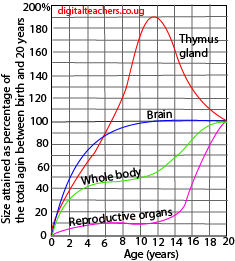

NB
- The head and hence the brain mature rapidly to take over the overall control of the body system
- Lymph tissue which produces white blood cells to fight infections grows rapidly in early life when the risk of disease is greater as the immunity has not been acquired.
- The reproductive organs grow slowly such that they are mature when the organism’s body is ready to support the fetus and to take care of the offspring.
Limited and unlimited growth
Growth in plant and animal show two basics of growth i.e. limited [definite or determinate] growth and unlimited [indefinite or indeterminate] growth
Growth in an annual plant is limited and after a period of maximum growth, during which the plant matures and reproduce, there is a period of negative growth or senescence before the death of the plant. If the dry mass of the annual plant is plotted against time then sigmoid curve given below as obtained
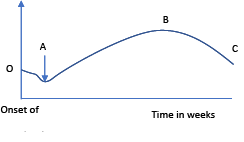
Explanation of the graph
-The negative growth in the first week is due to respiration of food reserves in the seed
-At A, the green leaves have now grown and opened above ground.
-Along AB, dry mass increases because photosynthesis is greater than respiration
-Along BC, dry mass decreases due to dispersal of fruits and seed, loss of leaves/chlorophyll and high respiration as compared photosynthesis.
Several organs show limited growth but do not undergo a period of negative growth e.g., leaves and stem internodes. Animals that show limited growth include insects, birds and mammals.
Unlimited growth is seen in woody perennial plants and some invertebrates, fishes and some reptiles
In plants growth only occurs in a group of immature cells called meristems.
The meristem has a number of defining features, including small cells, thin cell walls, large cell nuclei, absent or small vacuoles, and no intercellular spaces. It is divided into three zones.
- The zone of cell division is closest to the tip and is made up of the actively-dividing cells of the root meristem, which contains the undifferentiated cells.
- The zone of elongation is where the newly-formed cells increase in length, thereby lengthening the root and shoot
- The zone of cell maturation where the elongated cells differentiate into specialized cell types
There are three types of meristems: –
- Apical meristems: these are found at the tips of roots and shoots and are responsible for primary growth of the plants i.e., increase in length.


Role of apical meristem in growth
- Cell division and elongation causes an increase in length
- Bud primordium gives rise to bud which can develop gives rise to branches
- Pro-cambium gives rise to vascular tissue
Root cap meristem


Role of root cap meristem
- Root cap protects the delicate root tip
- Cell division and expansion leads to an increase in length
- Cell differentiation leads to the formation of different tissues
2. Lateral meristems: these are found in a cylinder towards the outside of the stem and roots. They are responsible for secondary growth and cause an increase in girth.
3. Intercalary meristems: these are found at the nodes in monocotyledonous plants. They allow an increase in length in positions other than the tip.
Experiments to determine the region of growth in a root
- Take a freshly-germinated bean with a root about 2.5cm long. Mark the root every 2mm with a line in permanent black ink.
- Pin the bean to the underside of cork, with the root hanging downwards, and put the cork into the moist cotton wool
- After 2-3 days, the region of growth is indicated by the part where the black line is longer than 2mm.


Germination
Seed germination may be defined as the fundamental process by which different plant species grow from a single seed into a plant
Conditions necessary for germination
-
Water
The role of water in seed germination maybe
- Dissolve and leak away germination inhibitors
- Soften and rapture seed coat to allow in water and oxygen
- hydrate vital activities of protoplasm
- converts the insoluble food into soluble form for its translocation to the embryo
2. Oxygen is necessary for aerobic respiration
3. Temperature; moderate temperature (250 -300C) activates enzymes.
Others
4. Light: some seed require exposure to sunlight before they germinate
.
Experiment to demonstrate conditions necessary germination
Prepare 4 test tubes as follow
Test tube 1: place dry seeds on cotton and place in a test tube in a warm place such that seeds are provided with air and warmth but no water
Test tube 2: seeds on cotton wool are placed in a test tube full of freshly boiled and cooled water and then covered with oil to prevent the entry of air.
Test tube 3: seeds in soaked cotton wool are placed in an open test tube and placed in a warm place. These seeds have warmth, oxygen, and water
Test tube4: seeds in soaked cotton wool are placed in an open test tube and test tube placed in a beaker if ice
The setup is left for a few days
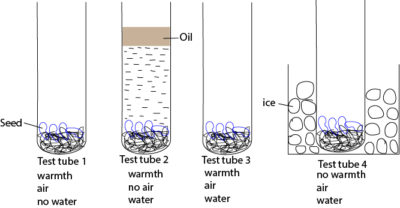
Observations
Seeds in test tube 3 germinated because they were provided with warmth, oxygen and water
Physiology of germination
- Germination starts with the rapid uptake of water by the seed through the micropyle by a process called ambition. Water then moves from the cell by osmosis.
- The water causes swelling of the embryonic tissue thereby rapturing the seed coat and also activates gibberellins.
- Gibberellins diffuse to the aleurone layer (a special layer which one cell thick that surrounds the endosperm). Here gibberellins cause the synthesis and activation of hydrolytic enzymes such as amylase and proteases.
- Amylase catalyzes the breakdown of starch to glucose while proteases catalyze the hydrolysis of proteins to amino acids.
- Glucose and amino acids are translocated from the storage centre (endosperm or cotyledon) of the seed to the growing regions of the embryo.
- Here glucose is used in respiration and in the formation of cellulose and other cell wall materials. Amino acids are used to make proteins, which are enzymes and structural components of protoplasm.
- Cell division, elongation, and differentiation lead to the emergence of a seedling from a seed.
Types of germination
-
Epigeal germination
Here hypocotyl grows faster than epicotyl causing the cotyledon to grow above ground

2. Hypogeal germination
Here epicotyl grows faster than hypocotyl that the cotyledons remain under the soil.

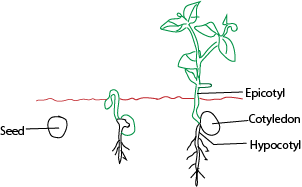
Intermittent growth in arthropods
Due to the inelastic nature of their exoskeletons, they appear to grow only in spurts interrupted by a series of moults. Significant growth is only possible when the new cuticle is still soft enough to allow the body to expand
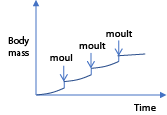

Molting is controlled by two main hormones: molting hormones (ecdysone) and juvenile hormone. Molting hormone is produced by a gland in the first thoracic segment called the prothoracic gland. Juvenile hormone is produced by a region behind the brain known as the corpus allatum. The production of both hormones is controlled by neurosecretory cells in the brain. All moults require moulting hormone. If the juvenile hormone is present in high concentration larval molts occur, which means the insect remains as a larva.
Metamorphosis
Applies to those changes which occur during the transition from larval to adult forms. It is very common in insect, frog and other amphibian’s metamorphosis to enable the different stage organisms to develop to fill different ecological niches which reduce competition.
Complete metamorphosis
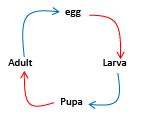

E.g. in butterfly
Incomplete metamorphosis

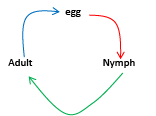
E.g. in cockroach
Senescence
Senescence refers to the body changes that lead to a decreasing life expectancy with age.
These changes include:
- Mental senility i.e. mental deterioration
- Atherosclerosis and arteriosclerosis which lead to hardening of arteries.
- The speed of impulse conduction in nerves decreases and so does sensitivity.
- Shrinking in body size
- Osteoporosis
- Hair becomes grey etc.
- The decrease in body sensitivity
For revision questions and answers download PDF, rewrite the notes to possess them, send comments for corrections
Growth in plants and animals (A-level)

thanks.i need full olevel biology notes
Good and so marvelous but I would like self evaluation studies of old curriculum BCM/ICT Combination notes if possible before I join HS next year
ingham county health department ivermectin stromectol
Wow! This blog looks just like my old one! It’s on a entirely different topic but it has pretty much the same layout and design. Great choice of colors!
Having read this I believed it was well-mannered informative I appreciate you taking the time and energy to put this content together.
Appreciate you sharing, great article.Really looking forward to read more. Want more.
elavil amitriptyline amitriptyline overdose amitriptyline interactions
Major thanks for the article. Great.
I’m excited to see what’s next! Home Improvement
I loved your article.Really looking forward to read more. Want more.
Thanks a lot for the blog article. Cool.
Thanks a lot for the blog post.Really looking forward to read more. Great.
Great, thanks for sharing this blog article.Much thanks again.
Your blog is a treasure trove of information. Sports News
browse tinder for free , tinder onlinetindr
What’s up friends, its wonderful article concerning tutoringand fully defined, keep it up allthe time.
always i used to read smaller content that as well clear their motive, and thatis also happening with this article which I am reading here.Here is my blog post … mpc-install.com
Experience streamlined admission at premier colleges with MBBS Direct Admission in Tamil Nadu.
I was recommended this blog by my cousin. I’m not sure whether this post is written by him as nobody else know such detailed about my problem. You’re wonderful! Thanks!
Get insights into competitive cutoffs with MBBS Cutoff Of Private Medical Colleges in Rajasthan.
I really liked your article post. Really Great.
Get started with Raja Luck and experience premium gaming like never before.
Thanks for sharing, this is a fantastic blog article.Much thanks again. Fantastic.
Major thanks for the blog post.Thanks Again. Awesome.
Find out how Raja Luck can impact you.
Greetings! Very helpful advice in this particular post!It’s the little changes that will make the most significant changes.Thanks a lot for sharing!
amoxil moa discount rx amoxil walmart 191115 american dental assoc amoxil before dental cleaning
When someone writes an paragraph he/she maintains the plan of a user in his/her mind that how a user can know it. So that’s why this piece of writing is amazing. Thanks!
Thanks for the blog.Really looking forward to read more. Cool.
Drive more visitors to your website by finding out to Increase website backlinks.
Thank you for your blog article.Thanks Again. Keep writing.
nolvadex side effects nolvadex for sale – nolvadex estrogen blocker
I am so grateful for your blog article.Really looking forward to read more. Cool.
I really like and appreciate your blog post. Cool.
A big thank you for your post. Will read on…
I cannot thank you enough for the blog post.Thanks Again.
Muchos Gracias for your blog.Really looking forward to read more. Cool.
I have been reading out some of your posts and it’s pretty clever stuff. I will surely bookmark your blog.
Greetings! This is my first visit to your blog!We are a collection of volunteers and starting a new initiativein a community in the same niche. Your blog provided us useful information to work on.You have done a marvellous job!
Get all the latest match reports and team analysis in Indian Football.
I think this is a real great blog post. Fantastic.
A round of applause for your blog post.Really thank you! Fantastic.
I really liked your post.Much thanks again. Will read on…
Get the most innovative servers at versatile rental plans with Server Rental in Delhi.
Muchos Gracias for your article. Really Great.
Great, thanks for sharing this blog post.Really thank you! Really Cool.
I really liked your article.Thanks Again. Keep writing.
Thank you for your article.Really thank you!
Wow, great article.Much thanks again. Really Great.
I cannot thank you enough for the blog post.Thanks Again. Really Great.
Great, thanks for sharing this post.Really thank you! Really Cool.
I appreciate you sharing this blog article.Really looking forward to read more. Great.
Im grateful for the blog article.Much thanks again. Keep writing.
Thanks so much for the blog post.Really looking forward to read more. Really Cool.
Looking forward to reading more. Great post.Really thank you! Want more.
Hi to every body, it’s my first go to see of this blog; this blog includes amazing and genuinely excellent material designed for visitors.
Piece of writing writing is also a fun, if you know then youcan write otherwise it is complex to write.
Im grateful for the post.Thanks Again. Really Cool.
I appreciate you sharing this blog post.Really thank you!
Wow, great article.Really looking forward to read more. Awesome.
Great, thanks for sharing this article.Thanks Again.
Im grateful for the article.Much thanks again. Great.
A big thank you for your article post.Thanks Again. Awesome.
Thank you for your blog.Thanks Again.
I really liked your post.Really looking forward to read more. Will read on…
Fantastic article.Really looking forward to read more. Much obliged.
Hey, thanks for the article post.Really looking forward to read more. Really Great.
Very neat article post.Really looking forward to read more. Really Cool.
I loved your article post.Much thanks again. Really Great.
Thanks for the blog post.Thanks Again. Fantastic.
Major thanks for the blog post.Really thank you! Really Great.
Thanks-a-mundo for the blog. Much obliged.
Thanks-a-mundo for the blog post.Really looking forward to read more. Really Great.
Hello there, just became aware of your blog through Google, and found that it is really informative. I?m gonna watch out for brussels. I?ll be grateful if you continue this in future. Numerous people will be benefited from your writing. Cheers!
Merely wanna say that this is very beneficial , Thanks for taking your time to write this.
Really appreciate you sharing this blog. Fantastic.
Hello, yup this piece of writing is genuinely pleasant and I have learned lot ofthings from it regarding blogging. thanks.
I don’t even know how I ended up here, but I thought this post was good.I don’t know who you are but definitely you are going to a famous blogger if you aren’t already Cheers!
I really like and appreciate your blog post.Thanks Again. Want more.
Great blog you have here.. It’s hard to find high-quality writing like yours nowadays. I really appreciate people like you! Take care!!
I truly appreciate this post. Keep writing.
wow, awesome article.
Really enjoyed this post.Really looking forward to read more. Great.
Enjoyed every bit of your article.Really looking forward to read more.
Awesome blog.Really looking forward to read more. Awesome.
Really informative article.Really looking forward to read more. Will read on…
I truly appreciate this article post. Really Great.
Thanks again for the article post.Much thanks again. Fantastic.
Enjoyed every bit of your blog.Much thanks again. Great.
This is one awesome blog article.Thanks Again. Great.
I really enjoy the article. Cool.
Enjoyed every bit of your blog article.Really looking forward to read more. Cool.
Major thankies for the blog.Much thanks again. Really Great.